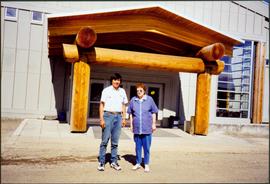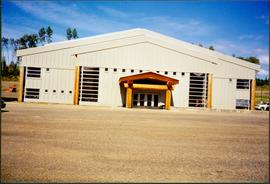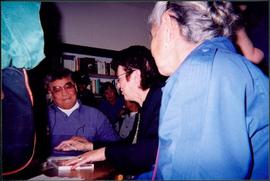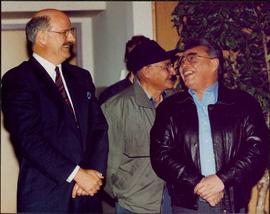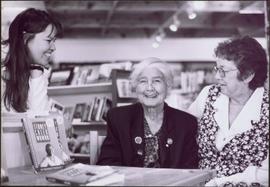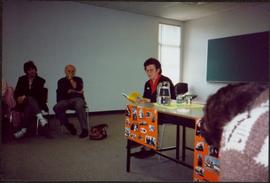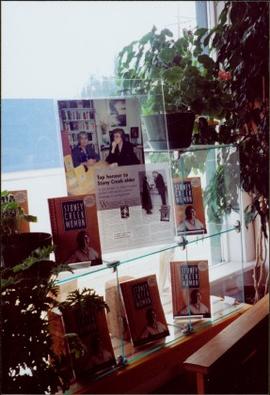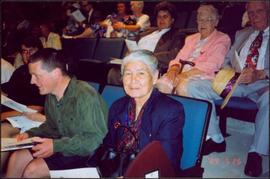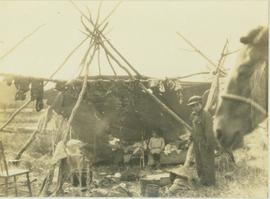Photograph depicts Moran standing with unknown man in front of building with large wood beams in entryway (see also item 2008.3.1.22.25 for image featuring Moran with this young man).
Photograph depicts unidentified building with large wood beams in entryway.
Photograph depicts Justa Monk and Bridget Moran seated at table, signing copies of 'Justa: a First Nations Leader'. Crowd stands gathered around.
File consists of "A comparative list of general Indian and non-Indian Values" developed by Joann Sebastian Morris, revised 1987; "Making Indians in British Columbia" by Michael Kew, revised 1986; a photograph of "Fort George", courtesy of the Provincial Archives of British Columbia, Visual Records Division, Catalogue No. 96295; Negative No.: G-3097; Newspaper articles from The Prince George Citizen: "Indians behind bars: Figures are Shocking", "Commentary: Compensation Deal Attempt to Right Wrong"; British Columbia Heritage Series: Our Native Peoples: Dene (series 1, volume 9,) a Social Studies Bulletin published by the Department of Education, The Government of the Province of British Columbia, 1953.
File consists of article by The Free Press: "New Judgement on old book" by Frank Peebles, Oct. 4, 1998 and a reprint order form for customers of Arsenal Pulp Press.
File consists of a handwritten letter from Mayo Moran to her mother Bridget re: the "Justa" draft (April 6, 1994), an annotated draft of "Justa," "Land Claims" pamphlet produced by the Carrier Sekani Tribal Council, and "Fort St. James Forest District Recreation Map" produced by the Province of British Columbia, Ministry of Forests (Dec. 1991).
File consists of newspaper clippings:
- "Surrender" (The Georgia Straight, July 19-26)
- "The Kemano deal: scientists, salmon sacrificed" (The Watershed, Nov. 1993)
- "Carrier-Sekani people speak for the fish" (The Watershed, Nov. 1993)
- "Alcan bid rejected by Court"(Canadian Press, Sept. 26, 1994)
- "Kemano hearings concluded" (The Democrat, Autumn, 1994)
- "What's up with Kemano II" (The Democrat, Spring, 1994)
- "How Kemano deal came to happen" (The Prince George Citizen, Aug. 13, 1994)
- "Memos reveal Kemano project conflicts ; editorial comments" (The Prince George Citizen, Oct. 14, 1994)
- "Kemano battle shifts to Ottawa" (The Prince George Citizen, Dec. 9, 1992)
- "Scientists condemn Kemano deal" (The Prince George Citizen, May 27, 1994)
- "North must stick together to protect river" (The Prince George Citizen, Feb. 6, 1993)
- "Controversy clouds start of hearings" (The Prince George Citizen, Nove. 9, 1993)
- "Alcan explains contract" (The Prince George Citizen, July 15, 1994)
- "Fisheries chief stays out of Kemano controversy" (The Prince George Citizen, April 7, 1994)
- "Kemano hearings reconvene in city" (The Prince George Citizen, July 19, 1994)
- "Exemption on Kemano ruled illegal" (The Vancouver Sun, May 25, 1993)
- "Kemano opponents get federal cash" ((The Prince George Citizen, March 31, 1994)
- "Ottawa joins Kemano project inquiry" ((The Prince George Citizen)
- "Your Opinion" ((The Prince George Citizen, Oct. 28, 1993)
- "Kemano hearings almost at an end" (The Prince George Citizen, July 23, 1994)
- "Siddon proud of Kemano deal" (The Prince George Citizen, July 22, 1994)
- "Former fisheries minister testifies" (The Prince George Citizen, July 21, 1994)
- "Social, economic costs of Kemano described here" (The Prince George Citizen, July 20, 1994)
- "Siddon anticipated" (The Prince George Citizen, July 16, 1994)
- Editorial comment on the Kemano project by Carolyn Linden (The Prince George Citizen, July 16, 1994)
- "Pulp mill's effects debated" (The Prince George Citizen, July 13, 1994)
- "Farming issues raised at Kemano hearing" and "Float plane operators worried about project" (The Prince George Citizen, July 12, 1994)
- "Vanderhoof wary about Alcan plan" (The Prince George Citizen, July 11, 1994)
- "Natives seek..." (The Prince George Citizen, June 4, 1994)
- "Where will the power from Kemano..." (The Prince George Citizen, June 11, 1994)
- "Scientists testify at inquiry" (The Prince George Citizen)
- "Threat to Tweedsmuir Park predicted"
- "Protesters disrupt inquiry" (The Prince George Citizen, June 24, 1994)
- "Power struggle" (The Weekend Sun, April 23, 1994)
- "Council rates Nechako 'most endangered river'" and "Alcan finds no evidence of PCB contamination" (Lakes District News, May 18, 1994)
- "Siddon wanted at hearings" (The Prince George Citizen, May 20, 1994)
- "Weed growth fears expressed" (The Prince George Citizen, July 8, 1994)
- "Chemical threat to river feared" (The Prince George Citizen, April 14, 1994)
- Newspaper advertisement: "Five things you should know about Kemano Completion" (The Weekend Sun, April 23, 1994)
- "Retired scientist says he was told to support gov't" (The Prince George Citizen, May 12, 1994)
- "Kemano opponents rifle paper" (The Prince George Citizen)
- "Court rejects Kemano challenge" (The Prince George Citizen, Feb. 4, 1993)
- "Kemano probe called 'a sham'" (The Prince George Citizen, April 14, 1994)
- "Special Kemano 'deals' denied" (The Prince George Citizen, July 15, 1994)
- "Nechako warning 'ignored' in '86" (The Prince George Citizen, May 4, 1994)
- "Scientists say deal bad" (The Prince George Citizen, May 7, 1994)
- "Kemano in jeopardy, gov't hints" (The Prince George Citizen)
- "Kemano inquiry promise sought" (The Prince George Citizen, July 14, 1994)
- "Kemano fight pledged" (The Prince George Citizen)
- "Kemano report 'shocks' natives" (The Prince George Citizen)
- "Single moms worst off"
- "Kemano won't be shut down" (The Prince George Citizen, Jan. 20, 1993)
- "Your Opinion" (The Prince George Citizen, Nov. 25, 1992)
- "Kemano queries keep group busy" (The Prince George Citizen, March 25, 1993)
- "Kemano project battle promised" (The Prince George Citizen, Feb. 5, 1993)
- "Indians get flooding settlement" (The Prince George Citizen, March 17, 1993)
- "A move to damn cabinet action in dam controversy" (Vancouver Sun, Jun 24, 1993)
- "Your Opinion" (The Prince George Citizen, April 7, 1993)
- "Fort Fraser folk just let it all hang out" (The Prince George Citizen, April 10, 1993)
- "Kemano answers demanded" (The Prince George Citizen, April 5, 1993)
- "Nechako 'worth more than a few lousy jobs'" (The Prince George Citizen)
- "Indians gather to reclaim heritage" (The Prince George Citizen, July 7, 1993)
- "Kemano hearings hit the road" (The Prince George Citizen, July 25, 1994)
- "Stand rapped" (The Prince George Citizen, Jan. 26, 1992)
- "Kemano-gov't conflict claimed" (The Prince George Citizen, April 11, 1994)
- "Natives could join inquiry" (The Prince George Citizen, Jan. 24, 1994)
- "Gov't kills Kemano project" (The Prince George Citizen, Jan. 23, 1995)
- "The Kemano decision" (The Prince George Citizen, Jan. 24, 1995)
- "Alcan breaks silence: Kemano decision criticized" and "Long, tiring battle over for Monk" (Prince George This Week, Jan. 29, 1995)
File also includes:
- River Views: Newsletter of the Allied Rivers Commission, vol.1, issue 2 (May. 1992) including Allied Rivers Commission "Policies and Objectives" (July 10, 1991) and "Nechako River winter flow comparison"
- River Views: Newsletter of the Allied Rivers Commission, vol.3, issue 1 (Nov. 1993)
- Blueprint: "Tanizul Timber Ltd. T.F.L 42, updated to 93 / 07
- Brian Gardiner, M.P. Campaign '93 Newsletter
- Gardiner Report - Update by Brian Gardiner, MP re: Fed must act on Kemano.
- Handwritten note by Bridget Moran re: Kemano project.
- Newsletter for the Nechacko Environmental Coalition, Edition 1:14 (Mar/April 1993)
- River Views: Newsletter of the Allied Rivers Commission, vol.2, issue 2 (March 1993)
- Information sheet re: public review of Kemano completion project.
Photograph depicts Justa Monk standing to right of Premier Harcourt in unknown room. John Alexis can be seen between them in background. Handwritten annotation on recto of photograph: "Justa Monk / John Alexis Tachie Village / The Premier / Taken in Prince George, B.C. Jan 23/95 / 'The day Kemano 2 was killed'."
Photograph depicts Moran seated to right of Mary John at table displaying copies of 'Stoney Creek Woman'. Unidentified woman stands on left, bookshelves can be seen in background.
Photograph depicts Moran reading excerpt from her book while seated beside table in classroom. Unidentified man and woman can be seen sitting in chairs against wall in background.
File consists of one draft and one original copy of a full page advertisement featuring four books written by Bridget Moran: Stoney Creek Woman, Judgement at Stoney Creek, A Little Rebellion, and Justa: A First Nations Leader.
Photograph depicts numerous copies of 'Stoney Creek Woman' (by Bridget Moran) in glass case. Display also features article on Mary John's receipt of the Order of Canada (see items 2008.3.1.22.61 and 2008.3.1.22.64 for photographs displayed in this image).
Item is a audio interview recorded by Bridget Moran with Jimmy, Rosie, Nancy, and Madeline.
Audiocassette Summary
00’ 05” Continuation of interview with Jimmy. Jimmy says his grandfather is French, not German, like Justa thinks. Moran and Jimmy continue to talk about the history of his grandparents. Jimmy continues to talk about his family history. They talk about the history of their last name, Monk.
12’ 08” Interview changes to Rosie. Moran asks Rosie about her siblings and other family history. Moran asks about the history of their last name, Monk. She believes her descendants are French. They continue to talk about her family history.
19: 22” Moran asks Rosie about the time Justa murdered John. Rosie talks about the situation candidly. She talks about John’s family life.
26’ 30” Moran asks Rosie about attending residential school. Rosie says school was alright for her, that they looked after them. She came home after six years.
28’ 30” Rosie talks about traveling around with her father because he worked many different jobs.
29’ 55” Rosie talks about getting married, how she got to choose her own partner, instead of having it arranged. She discusses her children.
32’ 05” Moran asks if Rosie had a good childhood. Rosie says yes, but her parents were strict. She remembers her father having to pay a land tax because they did not live on reserve land. She continues to talk about her childhood.
37’ 16” Rosie talks about life in residential school. Nancy says the nuns were kind; that they had to punish them if they spoke their native language.
38’ 50” Interview changes to Nancy. Moran asks about the history of their last name, Monk. They talk about her family history.
45’ 43” Moran asks Nancy about the time Justa killed his brother, John. Nancy talks about what she can remember.
47’ 32” Moran asks Nancy about the death of her brother, Teddy. She tells Moran the story she was told by the police.
49’ 34” Moran asks Nancy when she went to residential school. Nancy talks about having convulsions, so only spent two years there, then came home. When she was feeling better, she went back for another two years. She said her time there was not that bad, but she was homesick and lonely.
53’ 16” Moran asks Nancy if she had a good childhood. Nancy tells her she did, that they did everything for their parents.
56’ 07” Interview changes to Madeline. Moran asks about the history of their last name, Monk. Madeline does not know much about it. They continue to talk about the history of the family.
1:02’ 45” Madeline tells Moran about how she knocked Justa out with a block of ice because he was teasing her when they were children. Justa was a big tease, she says. Madeline says that Justa collected a box full of ‘treasure.’
1:09’ 10” Moran asks Madeline about her mother and how much she sewed for other people.
1: 10’ 44” Moran asks about when Madeline went to residential school. She tells Moran that she liked it there. Those who went there have discipline, she says.
1: 12’ 55” Madeline tells Moran that her parents were strict. She talks about being punished when breaking the rules, much like being at the residential school. They return to discussing residential school.
1: 17’ 55” Moran asks Madeline about what she remembers about the trips between Portage and Fort St. James. She talks about traveling by canoe once with her grandfather.
1: 20’ 33” Moran tells Madeline what she plans to write about in the book, particularly the first chapter dealing with the family history and life before the road being built to Portage.
1: 23’ 25” They return to talking about the family history, including aunts. They talk about her siblings.
1:30’ 07” Moran asks about Justa Hanson, the man Justa was named after. He was living in Tachie at the time Justa was born.
1:32’ 40” End of tape.
Item is a audio interview recorded by Bridget Moran with Justa Monk.
Audiocassette Summary
00’ 10” Moran asks Justa about living ‘three lives.’ Justa discusses the three phases of his life – childhood, getting in trouble, and being in a leadership role.
03’ 10” Moran asks Justa to discuss his older brother John. Justa talks about John and his personality and his relationships.
07’ 35” Justa discusses the trouble he got into with John. Justa does not remember what started the fight, because no one wanted to tell him what had happened. Justa does not remember killing his brother, but discusses how he wanted to commit suicide after finding out the truth. Justa also talks about his jail time.
24’ 14” Justa talks about his move to Dawson Creek to do upgrading. He still had the intention of Justa talks about adopting his niece.
26’ 03” They return to discussing Justa’s committing suicide. He felt guilty about taking his brother’s life. They also discuss his alcoholism.
35’ 25” Moran asks Justa about how he felt about being Indian or being treated as a second-class citizen. Justa says he is proud to be Indian.
38’ 35” Justa talks about being slapped as punishment for using his native language at school. He talks about kissing a girl and getting caught. He talks about his other punishments at residential school, and how he got tired of a specific teacher. He continues to discuss the school and assimilation into the ‘white world.’
53’ 35” Moran asks about the name he was named after, Justa Hansen, who was from Tachie. Justa talks about how Hansen was an important leader of the community.
55’ 52” Moran asks about ‘Indian’ food, such as deer, bear meat and salmon. He loves this type of food dried.
58’ 49” Moran asks Justa when he became tribal chief. He talks about the history of the position and how he became the tribal chief.
1: 03’ 30” Moran asks about Justa’s father’s potlatch. He talks about his parents’ death.
1: 07’ 17” End of tape.
Item is a audio interview recorded by Bridget Moran with Justa Monk.
Audiocassette Summary
00’ 10” Moran asks Justa to identify reserves on a map. Moran tells Justa she wants to start the book with the history of reserves Justa lived in or around. Justa was born in Fort St. James. Moran asks what he wants to name the book.
05’ 10” Justa talks about how long it took to get from place to place when he was a child. He talks about what types of transportation was used in the different seasons. He also discusses how the way of life changed when the road was built between Fort St. James and the other reserves. Moran suggests the road was bittersweet because of the loss of community.
25’ 30” Justa is concerned about the loss of Indian culture to younger generations, so speaks his language often. He also worries about the dependency First Nations have on modern conveniences, so have forgotten how to live off the land.
33’ 56” Moran asks how Justa feels about ‘culture camps.’
38’ 25” Moran asks Justa which clans are in Tachie, where he names several.
40’ 05” Moran tells Justa she has been reading his diaries and how she feels he is being killed by meetings once he became band manager. Justa says the meetings are beneficial to teaching himself what he needs to know.
42’ 35” Justa talks about his nervous breakdown because of the amount of meetings he had to attend, which he averages at about one thousand a year.
43’ 36” Moran asks Justa what the central concerns were for Tachie. Justa tells her hydro, sewage, telephone and cable services, and schools. Justa talks about the schools, in particular.
49’ 46” Justa talks about the new band manager of Tachie.
50’ 09” Moran asks about the Kemano Project. Justa tells her there are lot of uncertainties, but he is not sure what they are at the moment. Justa thinks the government will go ahead with Kemano II regardless of what the public think.
57’ 27” Justa talks to Moran about the qualities of being a leader. His father told him he was too radical to be leader and had to respect other people’s opinions and nationalities to be successful. People are more supportive of his ideas now.
1: 00’ 50” End of tape.
Item is a audio interview recorded by Bridget Moran with Justa Monk.
Audiocassette Summary
00’ 10” Moran asks Theresa about when she first started living with Justa. They discuss the beginning of their relationship. Theresa discusses her former husband, how she began drinking because of his abuse. She says Justa made her settle down.
11’ 22” Moran asks Theresa about the things her and Justa do together. She says they garden. She says he looks after her well, but in the past Justa ‘slapped her around’ when they were drinking. Theresa talks about her past with alcoholism and how it affected her relationship with Justa.
18’ 30” Moran asks about when Justa and Theresa got married. Theresa talks about the wedding. Theresa talks about how Justa’s parents initially did not accept her, but they eventually started to treat her well when they saw Justa and her were doing well.
21’ 35” Moran asks Theresa about her children. Theresa discusses them all individually. Two of her daughters were killed.
31’ 45” Moran asks Theresa about going to Tachie for salmon fishing. Theresa talks about the process of fishing from the shore. Theresa also talks about hunting and preparing for the winter.
37’ 45” Moran tells Theresa no names will be mentioned in the book, such as the last name of her first husband.
37’ 59” Moran asks Theresa why she thinks alcoholism is such a problem on the reserves nowadays.
42’ 59” End of tape.
Item is a audio interview recorded by Bridget Moran with Justa Monk.
Audiocassette Summary
00’ 06” Justa is talking about the Kemano II Project and what he said in a meeting with the Ministers. He has asked them to stop the Project or they will face judicial review because they are basing the Project on a political basis, not a scientific basis. He says he feels he will win the case.
04’ 57” Moran tells Justa she is working on the chapter about when he kills his brother John. Moran asks Justa about what happened and he tells her all he remembers is when the cops arrested him. They continue to talk about what happened, though Justa’s memory is vague. Justa talks about his time in prison.
24’ 54” Moran asks Justa about when he moved to Fort St. James after he was released from prison. He moved to Dawson Creek after being picked arrested again.
27’ 58” Justa talks about moving back to Tachie, then going to work for BC Rail in 1970. At that time, he was hired as band manager.
28’ 50” They return to discussing the Kemano II Project.
32’ 20” Moran and Justa return to discussing the murder of his brother.
34’ 50” Moran and Justa talk about Brother Anderson, who worked at the residential school.
41’ 15” Moran talks to Justa about his brother Alec who passed away at a young age. The person who fell off a roof was a cousin.
42’ 30” Moran asks Justa about being left on Haldi Road when he was working at the rehabilitation camp. He talks about Haldi Camp and it was decent living conditions. There was no counselling offered.
47’ 57” Moran asks Justa if his troubles at that time were related to alcohol. He tells her that his fights were caused from drinking. He talks about his parents telling him they were worried about his drinking. He began to black out, but did not worry about it because he says he was young and did not pay attention.
49’ 55” After Justa left Dawson Creek, he returned to Tachie. Two weeks after he was home, Teddy was shot. They talk about the circumstances surrounding his death.
56’ 08” Moran asks Justa about his memories of Tachie when he started as a maintenance man in the 1970s. He says the roads were rough or hardly there. He talks about his job shovelling snow or pulling vehicles out of the mud. They talk about the Tachie community in the early 1970s. Justa talks about building the community up.
1: 08’00” Justa talks about his wedding to Theresa. Very few people attended the wedding. It took a long time for Justa’s family to recognize her as part of the family.
1: 12’ 54” Moran asks Justa about life in Tachie. Justa tells her things were done collectively, there was no division within in the community. He wishes the old way of life was still a part of the community. He talks about the love of ‘potlatch’ in the community. He talks about how the old way of life disappeared once the road was built.
1: 19’ 50” Moran asks Justa what he is working on. Justa says he is wrapping up the treaty process, budget proposals, and a couple other issues. He talks about Kemano II. He is serious about leaving his position because he has been neglecting his family. They continue to talk about the Kemano II Project.
1: 29’ 09” End of tape.
Item is a audio interview recorded by Bridget Moran with Justa Monk.
Audiocassette Summary
00’02” Justa is talking about the store in Tachie.
02’ 13” Moran asks Justa to clarify his different positions when working for the band, and when he served in those positions. He talks about the years he was band manager and tribal chief, and talks about these positions. He discusses the stress of the positions because of lack of funding.
16’ 29” Moran asks Justa about the different programs, such as water systems and education. Justa discusses getting the water system into Tachie. He discusses the details of trying to get the water system, particularly trying to get funding and getting the proper contractors. He talks about the stress of the position and how it affected his mind.
39’ 04” Justa talks about the differences between being a band manager and a tribal chief. He tells her there were no politics involved in being a band manager.
41’ 30” Moran asks Justa to draw her a map of Tachie and Sunnyside for the book, so she knows where everything can be found. Justa draws her a detailed map that includes the lake and the river.
52’ 34” Moran asks Justa about his week as a band manager and tribal chief, starting from Monday to Friday. He talks about his meetings involving contracts, social assistance, education, and other funding concerns. He reads from his diary to Moran.
1:02’ 55” Moran asks Justa about when Tachie received a telephone system. Justa talks about how he actually regrets getting a telephone and television system because of the loss of community.
1:08’ 55” Justa returns to talking about Kemano II.
1:14’ 59” Moran’s voice is muffled and incomprehensible.
1:16’ 35” Moran asks Justa for photographs for the book. Moran wants a subtitle for the book, so asks Justa for something in Carrier. Moran tells Justa that the CBC has asked why she is writing a book about him. They discuss the general details of the book.
1:26’ 17” End of tape.
Audio recording consists of an interview conducted by Bridget Moran with Mary John.
Audiocassette Summary
Scope and Content: Recording starts referring to this as a continuation of previous discussion. Mary John talks about fishing and refers to tools in Carrier language.
0’01” She talks about having her children and the use of midwives – and laying of hands by the mid- wives as a healing ritual. There were no doctors in area where Mary had all her children. Recalls in 1946 going to Vanderhoof to see a doctor for one of the more difficult births. Talks about use of mid-wives at Pinchi Lake mines when they [her husband and her worked at] cutting wood for the mines there
8’00” Mary John recalls coming to Fort George – living in tent camp near the tracks. Her Husband worked for a man named Koop
9’00” Mary talks about her children going to Lejac, the Indian residential school “they were lonely and we were lonely….there was silence….everyone [kids] were gone” She recalls that the dids didn’t come home for Christmas – left in September and came back in June. Talks about transport of the kids “big truck” came to get them in the fall to bring them to Lejac.
Mary discusses her own school life at Lejac in 1922 at age 7 – recalls her initial thoughts about going to school; being delivered to the school; remembers talking to her parents once on the telephone from Lejac and being very homesick. Describes where the “Mission School” was located; recalls there were about 40 kids there. Talks about the teachers who were nuns and recalls various students at Lejac; notes she was there until 1927. She left school and a Mountie was sent after her to bring her to Lejac but her mother needed her to stay to look after the other children
20’00” Recalls an “Indian doctor” who came to town from “down south” who was not trusted by the local people who was ‘taking sickness’ out of people and ‘charging for it’ – caused a scandal – “singing hymns” heard he was from the Kootenays. [religious zealot?] they were afraid the Missionaries would punish the children for going to him.
21’00” Mary talks about being punished at Lejac – recalls running outside doors before whistle blew, and the sisters would whip them with a dry willow; says she wasn’t strapped but recalls seeing many strapped
22’00” Mary notes that spoke Carrier as first language and then in Fort St. James took a year to learn a little bit of English. She wasn’t aloud to speak her language at Lejac – she now feels ‘quite bitter’ about that and especially now most parents don’t speak Carrier or teach it to their children at home now
27’00” Mary notes there was no option to send her own kids to public school in Vanderhoof as they had to go to residential school
29’00” Mary John recalls one nice Scottish woman who she worked for in Vanderhoof c.1927
32’00” Mary John talks about where her kids went to school. She continues to talks about where native kids now go to school including at the Price George College
33’00” Mary John discusses her educational experiences at Lejac –
34’00” She recalls that the quality of the food at Lejac– it wasn’t good; too much porridge; not much meat; her job was to clean the dishes of the nun’s dinner tables so she would eat the remainder off their plates. Remembers occasionally getting fish smoked from a community resident and enjoying this
36’00” Discusses the church services at Lejac; singing lessons
38’00” Discusses outings from the school on the weekends including Robinson Point
41’00” Talks about picking roots as her job; recalls that the boys and girls were separated at the school; noted you would be spanked if you talked to a boy at the school; sexual interest shown between the girls and boys
44’00” Bridget asks about the girls experiences with menstruation – Bridget recalls a conversation ‘years ago’ when Bridget brought out a girl from India and that girls in India had to be separated when menstruating; Mary John notes that native girls also had to be isolated; it was considered an unclean time. It was the native belief that if a girl/woman had handled the meat/food for preparation during menstruating, it was considered bad luck for the hunters so the girls/woman were isolated from the community during that time of month.
51’00” Mary John herself did not believe in this custom. So there was a sense of relief when menopause came
End of that session Then tape starts again
51’05” Bridget notes it must have been difficult to talk to boys after boy-girl separation at Lejac; notes she was too shy to talk to boys
54’00” Bridget asks her to talk about her (Mary John’s) ancestors
Her Mother was Angele Quaw; her grandmother was known as ‘Six Mile Mary’
58’00” Bridget refers to a tape that she did many years ago with Granny Seymour and that Mary John may be able to make out some of the recording; Mary John notes that her mother was born in 1900; had Mary when she was only 13 with older man
61’00” Mary John talks about her biological father; had difficult relationship with him; he didn’t want a relationship as father-daughter
64’00” Mary talks about her mother’s marriage to Johnnie Paul at age 17; and they moved to Stoney Creek; they had 6 children; her mother died in 1934 in child birth.
68’00” Mary’s mother’s husband had died a month before she did; Johnnie Paul and James Antoine died at the same time from drinking bad home brew
71’00” Talks about taking care of her siblings after her mother’s death from childbirth
72’00” Talks about Johnnie Paul being a trapper and having a trap line at Stoney Creek
74’00” They discuss Mary John’s mother and grandmother genealogy; Quaw family of Fort George
78’00” Bridget asks her what her early memories would have been of Stoney Creek; Mary recalls tending to her mother during the flu epidemic. Recalls people being buried in blankets; too many people and no time to build coffins. Recalls Father Cocola and Lejac again.
84’00” Mary recalls going to their family hunting grounds at Cluculz Lake in September to hunt; use tents to stay in while hunting; stayed there about a month to hunt/snare animals. Recalls having a shack at Wedgewood in the winter where her step-father worked for the logging contractor.
89’00” begins to talk about memories of Wedgewood
End of tape
Audio recording consists of an interview conducted by Bridget Moran with Mary John.
Audiocassette Summary
Context: Recording is the continuation of earlier sessions by Bridget and Mary John talking about her life – appears to continue on from the other tape sessions numbered to #8 [Accession # 2008.3.1.211.4]
Side 1: “Mary John #9”
0’05” Bridget interviews Mary John and asks about Mary John’s grandmother who lived at the reserve at Fort George. Mary notes that her grandmother was sent back to Fort George and then to Stoney Creek after husband died. Her Grandmother remarried; she died in the 1950s. Mary talks about her grandmother’s marriage with Za (Jean) Paul – that was not an arranged marriage; her Grandmother “she had a hard life”
4’00” – 7’30” Mary Johns’ mother married Johnny Paul – not arranged; Mary notes that she was born in Fort George. Mary lived with her Grandmother Ann on reserve in Fort George. Mary then talks about her sister Bella – who married Mike Ketlo (sp?) and their children. She died of tuberculosis in the 1950s.
7’40” Bridget asks about the Mission School in Fort St. James – near the church “that is on Mission land” Which is where the village originally started. They talk about the church’s history briefly.
9’00”-14’00” Bridget asks Mary about her schooling at Lejac – Mary says they had reading, writing, arithmetic, penmanship and history. There was no science taught. Mary then describes the routine at Lejac. Doing chores and then breakfast at about 7:30 and then did cleaning chores in the dormitories. Then they attended their classes; then lunch, then played outside and then came back for sewing or embroidery, knitting and then back in classes until 4:00pm. Mary describes recreation – swimming, playing in the field, chores – pulling roots/stumps etc. Bridget talks about Joanne (Fiske?) thesis on the distinction between native boys and native girls’ activities and education at the residential school and that it enabled them to go to work in the hospitals and offices but that the farming education that was taught to the boys didn’t help them as there was no agriculture on the reserves. Mary notes she was ‘teachers pet’ as she had music lessons for singing. Mary notes she didn’t do anything in the kitchen but took mail to the post office and looking after the office for the Mother Superior. She feels she learned ‘the basics’ [but] then they ‘kicked you out at 16’
15’00” Bridget asks about the differences in disciplining methods of children – she notes that it is not part of Indian culture to spank children. She notes it is part of her husband’s sisters to discipline her children – not her or her husband’s duty
17’00” Mary talks about the residents at Stoney Creek who objected to school at Lejac because of harsh disciplinary methods used with their children
18’00” Mary talks briefly about the food at Lejac and speaks briefly to another unidentified woman [Sabrina?] in the room about food preparation [canning?]
19’50” Bridget asks about the Stoney Creek residents who wanted to have a school at the village in the 1950s and wanted their children to go to school there.
20’00” Mary speaks briefly about Father Coccola and that he did the negotiation about the move of the people from the reserve at Fort George to Shelley and about some compensation acquired by the residents. Bridget notes he ‘did not do a favour to the Indians’ – Mary notes that they were forced to leave ‘very illegal’
22’00” Mary speaks again about Father Coccola who could be ‘a very strict man’ but who took care of the people when they were sick and dying
23’00” Mary talks about another priest (unidentified) that she really liked who gave her a job c.1935 when she and her husband cleared land for Lejac and the priest treated them really well. She thinks he was from the Yukon as he had gold nuggets
25’00” Mary talks about her children going to Lejac in the 1950’s
26’00” Bridget talks about a social worker who came to Stoney Creek in c.1955 and Bridget was asked to come out by the Indian Agent to investigate what was the issue. This social worker was scared of being on the reserve; Mary thinks this woman had marital problems and drank a lot
28’00” Mary talks about the Day school operating c.1951 for a short time and the kids were bussed back and forth; other kids ‘orphans’ went to Lejac (lived there)
Tape is poor after this; noise with squeals and recording is faster
29’00” Mary talks about her children (Helen and the boys) not liking Lejac. She notes that one of the boys didn’t like it ‘but didn’t complain’ about it. She notes that ‘no one would talk about it’ “the whole village would be silent” when they left; and the children would be crying.
30’00”-33’00” Bridget asks Mary to discuss her wedding in more detail – Bridget notes that she already has on tape about the wedding night itself but asks for more information about the wedding day. Mary begins to talk about the wedding; there was a Mass, the guests and there was a band….
Tape is unintelligible after this; recording is broken up with interference and then there is no recording End of side 1
Side 2 “Mary John #10”
This side of the cassette has no recording
Audio recording consists of an interview conducted by Bridget Moran with Mary John.
Audiocassette Summary
00’05” Bridget is interviewing Mary John who discusses a potlatch held at Stoney Creek that Bridget attended. Bridget asks about the talking stick and she asks Mary John to explain its significance. Mary explains there had been a naming ceremony about a year ago and that a woman named Maisie had changed clans from her mother to her father’s clan. Mary notes while this is unusual, her father’s only son had died and therefore requested that the daughter changed clans. At this ‘September potlatch’ therefore this woman had to change tables at the potlatch.
04’00” Mary explains the context of the September Potlatch. She notes that Maisie had hosted this potlatch to pay back for the gifts that had been provided for her from a year ago when she received a new name. They then discuss the amount of money that the host gave to the guests and the amount of money that is normally provided – there is no particular amount ‘whatever you wish’ Mary notes she had provided Maisie with a gift last year of $100 but that Maisie gave her back $200 – that is not required – there is no required amount
07’30” Mary explains that at a potlatch you are expected to bring a case or few bags of food
08’00” Mary discusses the type of food provided at a potlatch; it is traditional food not western food; Bridget notes there was caribou provided there. Mary explains that the host of a potlatch asks people to hunt for moose and deer meat in order to prepare for the food to be served. Bridget then talks about the food that was served and Mary notes it included also fish and beaver.
11’00” Bridget asks Mary to talk about the gifts given to her daughter Flo at the potlatch in exchange for a loan she provided to another woman whose husband had died a year before. Bridget notes it was a ‘touching’ moment.
12’00” Mary talks about the Priest ‘Father Brian’ who was at the potlatch. Four clans collected money and gave it to the priest for his work [missionary work?]
15’07” Mary explains the situation of Geraldine Thomas –that at the potlatch she was not seated before; that is she was not initiated before and so she was seated at the potlatch
15’57” Tape stops momentarily
16’09” Mary continues to talk about Geraldine and the potlatch events; the significance of the tapping of the talking stick; then she was seated and guests give her gifts. Then Mary talks about Ernie and her late daughter Helen who also wanted to cross their clan but that Mary ‘did not let her go’
20’00” Mary talks about the feelings of a child who gives up their clan and that it is like ‘giving up one of your children’ as Celina noted to Bridget at the event.
21’00” Mary talks about her son Ernie who crossed over to his father’s clan and that he was gifted at the potlatch
22’00” Bridget then notes that at this potlatch that the Frog Clan became host of the Grouse clan at this potlatch. Mary explains that the clan then had debts to pay at this potlatch.
26’00” Mary talks about the death of Stoney Creek members; she is unsure when there will be another potlatch in Stoney Creek.
28’00” Bridget notes that she did not understand the ceremony as it was in Carrier language; however Bridget notes it is a pity the white world doesn’t see potlatches as they are ‘so touching’
31’00” Mary explains that each clan takes care of the deceased family members and takes care of putting up the headstone
32’00” Tape ends abruptly
Photograph depicts Mary John sitting next to aisle in Canfor Theatre at the University of Northern British Columbia in Prince George, B.C. Unidentified individuals seated in foreground and background. Accompanying note from Maureen Faulkner: "Mary John takes my seat." Photo taken on the day Bridget received an Honourary Law Degree, before ceremony began.
Photograph depicts a First Nations family consisting of a woman and four children standing underneath or next to a lean-to style tent. Meat is drying above the campfire and a horse's head is visible in the foreground.
Video recording is a compact VHS recording of the construction of the ceremonial mace (Talking Stick) for the University of Northern British Columbia.
Video recording is a compact VHS recording of a feature for CBC Prince Rupert about the construction of the talking stick and ceremonial chairs (President's Chair and Chancellor's Chair) for the University of Northern British Columbia.
Video recording is a VHS recording of the construction of the Senate chamber doors for the University of Northern British Columbia.
Video recording is a VHS recording of the making of the Ceremonial Chairs and Mace (Talking Stick) for the University of Northern British Columbia.
File consists of Misc. typewritten notes under the following titles: the name "Nulki Lake," indian medicine, alcohol on reserve, housing on reserve, T.B. on reserve, indian agent, the Watchmen, the Church, alcohol, and families on Stoney Creek; typewritten notes under the following titles: early life, ancestors, Mary's childhood (racism), Mary's childhood (menstruation), Mary's childhood (the 1918 Flu), Mary's childhood (on the trapline), Mary's childhood (the trapline), Mary's childhood (her first coat), Mary's childhood (Christmas), and Mary's childhood (camping out and going to a Potlach); typewritten notes under the following titles: Mary's school days, childbirth, school life of Mary's kids, Mary's marriage, Lazarre's mother, marriage - housing, marriage - children, marriage - shopping in town, marriage - finances, marriage - work, work - depression, Indian Agent, marriage - hard work, camping, Lazarre's cabin at Wedgewood, doing hides, social life, whites, survival, Lazarre's family, Indian Agent and department of Indian Affairs, politics on reserve, citizen of the year, Catholic school, hides, potlach, siblings, net fishing, and changes; Lejac School: Thesis "And Then We Prayed" (pages 1 - 9) and questions for Mary.
File consists of computer disk with "over[looked?] oral histories" files. Slides primarily contain pictures of women who were the subjects of Ainey's research.
File consists of course outlines, drafts of articles on Catharine Parr Traill and draft sections of "Creating Complicated Lives: Women and Science at English-Canadian Universities, 1880-1980."
File consists of conference proceedings relating to presentations on Catharine Parr Traill and Ainley's research project, "Re-explorations: new perspectives on gender, environment and the transfer of knowledge in 19th and 20th century Canada and Australia"; correspondence; notes on a publication; and notes on Louise de Kiriline Lawrence correspondence.
File consists of the components for Ainley's Social Science and Humanities Research Council (SSHRC) grant, "Re-Explorations: Science and Environment in 19th and 20th Century Canada and Australia" and conference proceedings from presentations of her research; a book chapter, entitled, "Gendered Careers: Women Science Educators at Anglo-Canadian Universities, 1920-1980"; Ainley's article, "Re-centering women in the landscape: A post-colonial feminist historian looks at gender, science and the environment in Canada"; and correspondence about edits for a publication.
File consists of consent, permission and ethics forms associated with the data collection for Ainley's research project, "Re-Explorations: Science and Environment in 19th and 20th Century Canada and Australia"; conference proceedings and notes for conference proceedings; notes on research projects; and a curriculum vitae.
File consists of conference proceedings from Ainley's presentations, "'Gynopia' at Work: Gendered Careers in Canadian Science," "Gendered Careers: Canadian women in science, 1890-1970," "Re-explorations: science and environment in 19th and 20th century Canada and Australia" and "Women and the Popularization of Science: 19th-century Women Science Writers in Canada"; an annual report for the University of Northern British Columbia; notes; and other material.
File consists of articles, some of which are in progress, conference presentations, notes and a bibliography.
File consists of versions and components of Ainley's Social Science and Humanities Research Council (SSHRC) grant, "Re-explorations: science and environment in 19th and 20th century Canada and Australia"; conference proceedings from a presentation of "Tracking Life Course Changes. Canadian Women in Science"; and Ainley's book chapter, "Gendered Careers: Women Science Educators at Anglo-Canadian Universities, 1920-1980."
File contains material, based on research in Australia, for Ainley's research project, "Re-explorations: science and environment in 19th and 20th century Canada and Australia." It consists of bibliographies, lists of archives with relevant material, a list of persons to contact and a list of recipients of Aboriginal knowledge.
Series consists of posters, newsletters, maps, reports, articles, statements, conference proceedings, background papers, correspondence, newspaper clippings, pamphlets, declarations, brochures, memoranda, proposals, speeches, publications, court documents, and telexes related to Walt Taylor's direct involvement with, or indirect research into, the following First Nations groups, individuals and events: Gitksan-Wet'suwet'en Tribal Council; Gitksan-Carrier Tribal Council; Cariboo Tribal Council, Tahltan Nation, Nisga'a Tribal Council, Union of B.C. Indian Chiefs, Council of the Haida Nation, Cree Nation, Leonard Peltier (Anishinabe and Dakota/Lakota Nations) Iroquois Nations, Nazko Nation, Kluskus Band and the Delgamuukw et al v. The Queen court case.
File consists of an oral history given by Heinz Bartkowski, which was gathered as part of Dr. Mike Evan's Island Cache Recovery Project. Includes consent forms, transcripts, and the recorded oral history on the original media.
File consists of an oral history given by Rose Bortolon and Ruth Cunningham, which was gathered as part of Dr. Mike Evan's Island Cache Recovery Project. Includes consent forms, transcripts, and the recorded oral history on the original media.
File consists of an oral history given by Elizabeth Carifelle and Doug Carifelle, which was gathered as part of Dr. Mike Evan's Island Cache Recovery Project. Includes consent forms, transcripts, and the recorded oral history on the original media.
File consists of an oral history given by Freda Evans, which was gathered as part of Dr. Mike Evan's Island Cache Recovery Project. Includes consent forms, transcripts, and the recorded oral history on the original media.
File consists of an oral history given by Pat Foreman, which was gathered as part of Dr. Mike Evan's Island Cache Recovery Project. Includes consent forms, transcripts, and the recorded oral history on the original media.
File consists of an oral history given by George Lamanes, which was gathered as part of Dr. Mike Evan's Island Cache Recovery Project. Includes consent forms, transcripts, and the recorded oral history on the original media.
File consists of an oral history given by Dorothy Lamb, which was gathered as part of Dr. Mike Evan's Island Cache Recovery Project. Includes consent forms, transcripts, and the recorded oral history on the original media.
File consists of an oral history given by James Larson, which was gathered as part of Dr. Mike Evan's Island Cache Recovery Project. Includes consent forms, transcripts, and the recorded oral history on the original media.
File consists of an oral history given by Sherry Lewis, which was gathered as part of Dr. Mike Evan's Island Cache Recovery Project. Includes consent forms, transcripts, and the recorded oral history on the original media.
File consists of an oral history given by Marie McRae, which was gathered as part of Dr. Mike Evan's Island Cache Recovery Project. Includes consent forms, transcripts, and the recorded oral history on the original media.
File consists of an oral history given by Alistair McVey, which was gathered as part of Dr. Mike Evan's Island Cache Recovery Project. Includes consent forms, transcripts, and the recorded oral history on the original media.
File consists of an oral history given by Bjorn Norheim, which was gathered as part of Dr. Mike Evan's Island Cache Recovery Project. Includes consent forms, transcripts, and the recorded oral history on the original media.
